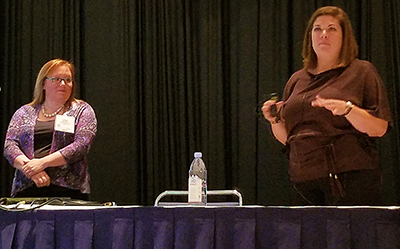Grocery stores have a $6 billion opportunity to attract more Millennial households to their stores and can begin to do so by tailoring their private label strategy based on a better understanding of how this generation consumes both food and marketing, presenters at FMI Connect said, Wednesday.

In a presentation highlighting proprietary purchase data, Angela Myers and Megan Margraff of Oracle Data Cloud said that although Millennials are just as likely as Gen Xers and Baby Boomers to be “core” shoppers, the overall percentage of Millennial households living within five miles of a grocery store and actively shopping that store is about 6% lower than that of older generations. This “conversion gap” is about a $6 billion opportunity for grocery stores, Myers said.
“That’s only looking as if you were to reach and convert more Millennial shoppers,” Margraff pointed out. “There’s also been a lot of research done that shows that Millennials tend to skew toward alternative formats and they’re accelerating the leakage to other channels including online shopping. And so in addition to that opportunity to simply convert more Millennials you also have another opportunity to drive greater share of wallet from Millennials that are already shopping with you today.”
Key to this is offering what Margraff called “simplifed value” with greater appeal to Millennials — a group that requires value due to economic constraints but also are not the deal-chasers their parents were. About half of Millennial households earn less than $50,000 a year, and about half have a negative net worth, Myers said. As a result, Millennial shoppers tend to skew toward value-priced brands more than older cohorts, but at the same time display less price-point sensitivity, and tend to be below-average deal seekers.
Millennials spend a smaller percentage of their dollars on items promoted on the front page of as circular “and even when they’re shopping for private label, they tend to spend less on deal and more at full-price,” Margraff said.
This behavior represents a sharp contrast to Baby Boomers, “who tend to skew toward premium and super-premium items but are very price-point sensitive and tend to be very aggressive deal seekers,” she added. “That’s not the case for Millennials, which we think is an opportunity for the industry as a whole to shift away from this heavy deal-dependence that we’ve created and trained shoppers on for decades.”
Private label can play a big role in a “simplified value” approach, she added.
“Private labels make up a greater percentage of Millennials’ total spending in a year than it does for either Gen X or Boomers, and they are shopping private label on more of their trips. “So private label today is already more developed with Millennial shoppers, but we think there’s an opportunity to really take private label programs and tailor them more to the unique needs of the Millennial shopper.”
Millennials over index for private label in about one-third of 350 categories studied by Oracle. “Those that pop to the top tend to be fresh departments — beef, chicken, pork, deli bulk meat, deli prepared chicken, value added fruit, refrigerated juices and drinks and even carbonated soft drinks, which is one of the most brand-focused categories in the grocery store today,” Margraff said.
Grocery stores also need to refine how they market to younger shoppers, the speakers maintained, noting the generation tends to participate less in the kinds of discount-heavy promotions that older shoppers do, such as gas-rewards programs. In particular, Margraff said, new and lapsed customer acquisition efforts tend to have little effect on younger shoppers.
“While we know we have a conversion gap with Millennials it may be easy for a store to say, ‘I’ll run a new shopper program to appeal to them.’ But this is exactly the type of discount-centered program that doesn't appeal to the Millennial shopper,” she said.
Millennials are more likely to respond to mobile and web offers than older shoppers and tend also to respond to promotions with a more personalized lifestyle approach, such as baby clubs and pet clubs.
The presenters said Oracle's purchase data tends to support survey data on Millennial eating preferences: They like fresh and easy to prepare foods, want to eat healthy, and they have a taste for authentic ethnic flavors, particularly Hispanic and Asian.
Millennial households “can’t be put into one bucket or another in terms of their flavor profile but flavor is important. Flavor matters,” Myers said.
“This convergence of convenience, interest in a healthy lifestyle and an international palate represents a unique and pretty untapped opportunity in CPG retail with a few exceptions,” she added. “If you walk into the average grocery store today and look at the prepared, convenient meals options in the deli section, it’s not necessarily healthy, and it’s not necessarily appealing to the international palate that today’s consumer has.”
| Suggested Categories | More from Supermarket News |
 |
|
 |
|



